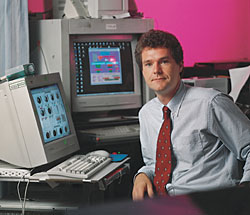Together is better than alone, finds DMS-Thayer team
Redundancy is often a good thing—in plane engines, computer backups, or emergency exits. But biological redundancy— the existence of multiple biochemical pathways to one effect —is a problem when it comes to treating cancer or, for that matter, any disease.
That's because a drug or radiation may block one pathway but not the ultimate effect. For this reason, it has long been recognized that combining two or more drugs that have different mechanisms may produce a better result—a phenomenon called synergy. Multidrug therapy with four or more agents is now common in cancer chemotherapy and AIDS therapies.

|
|
Brian Pogue, who's on the faculty at Dartmouth's Thayer School of Engineering, is
collaborating with colleagues at Dartmouth Medical School to find ways to boost the
effectiveness of cancer therapies by carefully timing their administration. |
Twist: A new twist in combination therapy was the subject of a recent paper in Cancer Research by a team of investigators at Dartmouth Medical School and Dartmouth's Thayer School of Engineering.
For the past decade, there's been interest in combining photodynamic therapy (PDT) and radiation to treat some cancers. "But," says Brian Pogue, an associate professor of engineering, "although additive effects were recognized, until our study no one had been able to show a synergistic effect between PDT and radiation. One reason is that previous studies largely focused on test systems in cell cultures, and we now know that some types of synergism between PDT and radiation may only be demonstrated in whole animals."
Harold Swartz, M.D., Ph.D., a professor of radiology at DMS who collaborated with Pogue on the study, outlines a typical treatment: "One would begin by injecting a semi-synthetic porphyrin, verteporfin [VP], intravenously. The VP would distribute throughout the body, although there seem to be somewhat higher concentrations in tumor tissue than in normal tissue. Perhaps this is because the blood vessels in tumor tissues are leakier than they are in normal tissue, and this allows more VP to leak into the tumor. Moreover, VP seems to be cleared from normal tissue more rapidly than from tumor tissue. So during critical time periods, there is some degree of selectivity of the tumor for the porphyrin."
Then, says Swartz, a laser is precisely focused on the tumor, further increasing the specificity of the treatment. This converts some of the oxygen in the tumor to a highly toxic free-radical form called singlet oxygen, which destroys tumor cells.
Timing: Timing is all-important, because PDT with VP can alter tumor oxygen tension in either direction, depending on the interval between the processes. If phototherapy is delivered soon after the VP, most of the VP will still be in the blood and the toxic singlet oxygen will be produced in the blood vessels. This effect can damage the vasculature, impair blood flow, and block oxygenation of the tumor— decreasing the effectiveness of the PDT.
If, instead, PDT is delivered three hours after VP, most of the VP has moved into the tumor cells and other tissues, optimizing the effect of the PDT. Moreover, singlet oxygen tends to damage mitochondria, the power plants of cells, causing the oxygen content of the tumor to rise above normal levels.
This leads to increased cellkilling when the tumor is subjected to radiation, which targets DNA. On this schedule, the two treatments together are clearly superior to the sum of both by themselves.
The tumor model used in the Dartmouth study was a mouse subcutaneous fibrosarcoma, so that the laser could be applied externally. But what about deeper tumors? Julia O'Hara, Ph.D., a research associate professor of radiology, explains that the PDT can also "be delivered by fiber optics, so the delivery system can be threaded to internal tumors." In the case of a bladder tumor, for example, the fiber optics could be introduced through a catheter in the urethra. Even tumors in the abdominal cavity and parts of the chest cavity could be accessed through small incisions.
When asked what's next for the team, Pogue replies, "Step one is the same as in all research projects—namely to get the grant renewed. After that, we plan to try to target approaches to prostate cancer."
If you would like to offer any feedback about this article, we would welcome getting your comments at DartMed@Dartmouth.edu.
